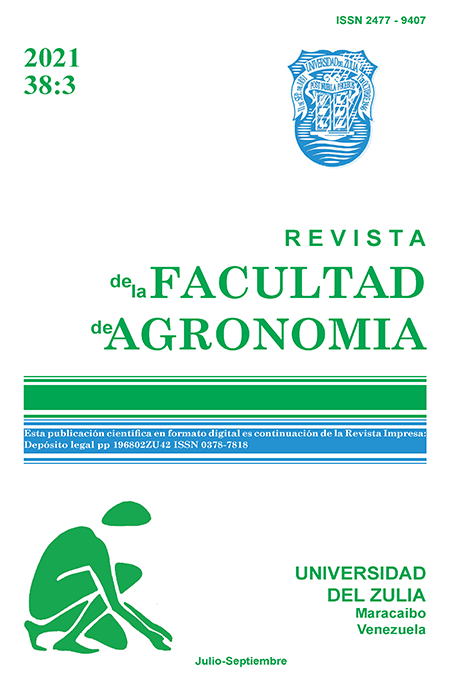Respostas fisiológicas e morfológicas de raízes em combinações de patrões e clones de cacau ao déficit hídrico
Resumo
A enxertia é uma prática comum no cacau e não tem sido relatado se as combinações padrão-enxerto apresentam diferentes respostas hídricas, crescimento e absorção de nutrientes em diferentes condições de disponibilidade de água. Os efeitos do déficit hídrico no potencial hídrico (Ψf), diâmetro basal (db) e crescimento radicular, clorofila e nitrogênio foliar (N) foram avaliados em 16 combinações padrão-enxerto que resultaram de quatro padrões e quatro enxertos ou clones. As mudas enxertadas foram submetidas a dois regimes de água: 21 dias sem irrigação (WD) e irrigação contínua (I). Sob condições WD, a tendência de menor Ψf foi encontrada usando o clone EETP800 com os quatro padrões, indicando uma taxa de transpiração mais alta que este clone pode ter. Enquanto os maiores Ψf (p <0,05) obtidos com os padrões EET 400 e EET399 indicam uma melhor capacidade de captação de água pelo sistema radicular desses padrões, o que permite manter taxas transpiratórias adequadas e maiores Ψf. Isso pode confirmar que no cacau os padrões podem regular a capacidade de água. Os maiores teores de db, clorofila e N foliar obtidos nas combinações com o padrão EET400 em WD conferem-lhe uma melhor capacidade de tolerar o déficit hídrico, porém esta capacidade não está associada a um maior crescimento radicular no déficit hídrico, o que indica que a maior eficiência da absorção de água está relacionada a processos metabólico-fisiológicos e não a uma superfície radicular maior que permite maior absorção de água.
Downloads
Referências
Baron, D., A. C. Amaro, A. Pina and G. Ferreira. 2019. An overview of grafting re-establisment in woody fruit species. Sci. Horticulturae 243: 84-91.
Barrios-Macias, F.H, T. Knipfer and A.J. Mc Elrone. 2015. Differential responses of grapevine rootstocks to water stress are associated with adjustments in fine root hydraulic physiology and suberizarion, J. Exp. Bot. 66: 6069–6078.
Boza, E., J. Motamayor, F. Amores, A. Cedeño, C. Tondo, D. Livingstone and J. Schnell. 2014. Genetics characterization of the cacao cultivar CCN 51: Its impact and significance on global cacao improvement and production. J. Am. Soc. Hort. Sci. 139: 219-224.
Carr, M.K.V and G. Lockwood. 2011. The water relations and irrigations requeriments of cacao (Theobroma cacao L.): a review. Exp. Agr. 47:653-676.
Chaves, M, M. Costa, O. Zarrock, C. Pinheiro, C. Lopes and J. S. Pereira. 2016. Controlling stomatal aperture in semiarid regions: the dilema of saving water or being cool. Plant Sci. 251: 54-64.
Donat, MG, L.V. Alexander, H. Yang, I. Durre, R. Vose, R.J.H. Dunn, KM. Willett, E. Aguilar, M. Brunet, J. Caesar, B. Hewitson, C. Jack, A. M. Klein-Tank, A.C. Kruger, J.A Marengo, T.C. Peterson, M. Renom, C. Oria-Rojas, M. Rusticucci, J. Salinger, A. Sanhouri-Elrayah, S.S. Sekele, A.K. Srivastava, B. Trewin, C. Villarroel, L.A Vincent, P. Zhai, X. Zhang and S. Kitching. 2013. Updated analyses of temperature and precipitation extreme indices since the beginning of the twentieth century: The HadEX2 dataset. J. of Geoph. Res.: Atmospheres 118:2098-2118.
Gambetta, G, T. Knipfer, W. Fricke and A.J. Mc Elrone. 2017. Aquaporins and Root Water Uptake, 133-153. In: Chaumont, F. and S.D. Tyerman (Eds), Plant Aquaporins: From transport to signaling. Springer DOI 10.1007/978-3-319-49395-4_6.
Garcia, J. and L. Moreno. 2015. Respuestas fisiológicas de Theobroma cacao L. en etapa de vievero a la disponibilidad de agua en el suelo. Acta Agronómica. 65 (1):44-50.
Goncalves, B, J. Moutinho-Pereira, A. Santos, A. Silva, E. Bacelar, C. Correia and E. Rosa. 2006. Scion-rootstock interaction affects the physiology and fruit quality of sweet cherry. Tree Phys. 26: 93-104.
Goenaga, R., S. Guiltinan and H. Seguine. 2015. Yield performance and beand quality traits of cacao propagated by grafting and somatic embryon-derived cutting. Hort. Science. 50 (3): 358-362.
Irizarry, H. and R. Goenaga. 2000. Clonal selection in cacao based on early yield performance of grafed trees. J. Agr. U. Puerto Rico. 84, 153–163.
Jaimez, R, F. Amores, A. Vasco , R.G. Loor, O. Tarqui, G. Quijano, J. Jimenez and W. Tezara. 2018. Photosynthetic response to low and high light of Theobroma cacao L. growing without shade in an area of low evaporative demand. Acta Biol. Colomb. 23 (1):95-103.
Jaimez, R., D. Vera, A. Mora, R.G. Loor and B. Bailey. 2020. A disease and production index (DPI) for selection of Cacao (Theobroma cacao L.) clones highly productive and tolerant to pod rot diseases. Plant Pathology.
Keller, M., L.J. Mills and J.F. Harbertson. 2012. Rootstock effects on deficit-irrigated wine grapes in a dry climate: vigour, yield formation, and fruit ripening. Amer. J. Enology Viticulture. 2012; 63: 29–39.
Leonardi, C. and F. Giuffrida. 2006. Variation of Plant Growth and Macronutrient Uptake in Grafted Tomatoes and Eggplants on Three Different Rootstocks. Eur. J. Hort. Sci. 71 (3): 97–101.
Loor, R., F. Amores, S. Vasco, J. Quiroz, T. Casanova, A. Garzón, I. Sotomayor-Cantos, J. Jiménez, O. Tarqui, G. Rodríguez, G. Quijano, L. Plaza, H. Guerrero and F. Zambrano. 2019. INIAP-EETP-800 ‘Aroma Pichilingue’, nueva variedad ecuatoriana de cacao fino de alto rendimiento. Rev. Fitotecnia Mex. 42 (2): 187 – 189.
Martínez-Ballesta, C., C. Alcaraz-López, B. Muries, C. Mota-Cadenas and M. Carvajal. 2010. Physiological aspects of rootstock–scion interactions. Sci. hortic. 127: 112–118.
Motamayor J.C., P. Lachenaud, J.W. da Silva e Mota, R. Loor, D.N. Kuhn, J.S. Brown and R. Schnell. 2008. Geographic and Genetic Population Differentiation of the Amazonian Chocolate Tree (Theobroma cacao L). PLoS ONE 3(10): e3311. Available in: https://doi.org/10.1371/journal.pone.0003311
Orchard, J. E. 1985. The effect of the dry season on the water status of T. cacao in Ecuador. In Proceedings of the 9th International Cacao Research Conference, Lomé, Togo, February 1984, p: 103–109.
Pantin, F, F. Monnet, D. Jannaud, J.M. Costa, J. Renaud, B. Muller, T. Simonneau and B. Genty. 2012. The dual effect of abscisic acid on stomata. New. phytol. 197: 65-72.
Pautasso, M., T. Doring, M. Garbelotto, L. Pellis and M. Jeger. 2012. Impacts of climate change on plant diseases-opinions and trends. Eur. J. Plant Pathol. 133: 295-313.
Santos, I., A.A. De Almeida, T.D Anher, A. Da Conceiçao, C. Pirovani, J. Pires, R. Valle and V. Baligar. 2014. Molecular, physiological and biochemical responses of Theobroma cacao L, genotypes to soil water deficit, Plos One 9 (12): e115746. DOI:10.1371/Journal,pone.0115746.
Sharma, R. M., A.K. Dubey, O.P. Awasthi and K. Charanjeet. 2016. Growth, yield, fruit quality and leaf nutrient status of grapefruit (Citrus paradisi Macf.): Variation from rootstocks. Sci. hortic. 210: 41-48.
Ribeiro, M., A.A. Almeida, T. Alves, K. Gramacho, C. Pirovani and R. Valle. 2016. Rootstock x scion interations on Theobroma cacao resistance to witches broom: photosynthetic, nutritional and antioxidant metabolism responses. Acta Physiol. Plant. 38:73. https://doi.org/10.1007/s11738-016-2095-9.
Tramontini, S, M. Vitali, L. Centioni, A. Schubert and C. Lovisolo. 2013. Rootstock control of scion response to water stress in grapevine. Environ. Exp. Bot. 93: 20–26.
Yin, J.P.T. 2004. Rootstock effects on cocoa in Sabah, Malaysia. Exp. Agr. 40: 445–452.
Warschefsky, E, L. Klein, M. Frank, D. Chitwood, J. London, E. Wettberg and A. Miller. 2016. Rootstock: Diversity, domestication and impact on shot phenotypes. Trends. Plant Sci. 21: 418-437.
Direitos de Autor (c) 2021 https://creativecommons.org/licenses/by-nc/4.0/

This work is licensed under a Creative Commons Attribution-NonCommercial-ShareAlike 4.0 International License.


















